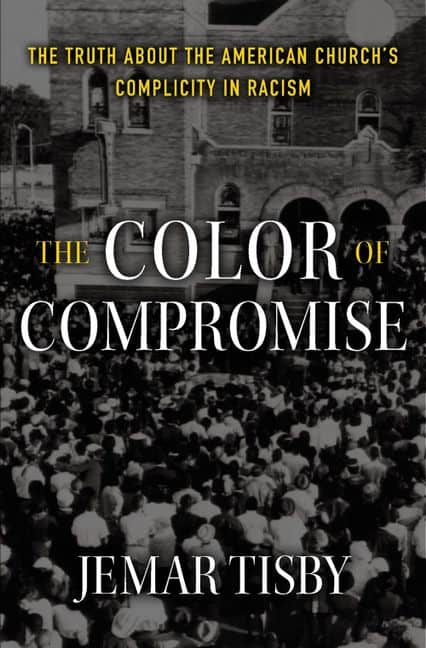
Editor’s Note: The Color of Compromise hit the New York Times Best Sellers list for the week of June 28th. In response, author Jemar Tisby writes: “I’m feeling a mix of emotions right now…It’s great news that my book has made the New York Times Best Sellers list. But at the same time, knowing what it took to get there and what sparked this renewed interest in the topic of racial justice—the murders of George Floyd, Breonna Taylor, Ahmaud Arbery, and on and on—is sobering.”
We are reprinting this review of The Color of Compromise, which first ran in 2019.
I don’t know if I’ve ever purposefully started reading a book knowing that I would undoubtedly struggle with its pages in a way that would make me wonder: Do I really want this? Do I actually want this to change me? As much as I’d like to think of myself as being good at self-reflection, I am definitely a pro at running from the uncomfortable and the hard.
Yet I knew I had to consciously (and stubbornly) take a different approach with Jemar Tisby’s debut book, The Color of Compromise: The Truth About The American Church’s Complicity In Racism. As is true throughout history, there are points in life when it is futile to ignore the call of God for change. To turn away from this call would mean choosing to live in a lie, a mythical nostalgia when some of us were “great.”
To turn away from this call would mean choosing to live in a lie, a mythical nostalgia when some of us were “great.”
The Color of Compromise is a clear example of God’s call for change, particularly for white people. Throughout his book, Tisby is careful to tell the reader how things really were at various points in the American Church’s history, all the while reminding us that there have always been opportunities to follow a different path and what people did with those opportunities. He challenges us to look at painful truths, not with the intention of producing guilt, but rather in hopes that readers will deal with what he refers to as “Godly grief” in order to attain true repentance and empathy.
In the first chapter, Tisby explains that the book is a historical survey: a quick run-through of a large swath of history that will reveal important patterns. Full coverage of every detail contributing to the immense role the American Church has played in constructing racism in this country would be an impossible feat for just one book, but even as a historical survey, Tisby covers a lot of ground in 268 pages. He takes the reader from Colonial America and the beginning of the enslavement of African peoples to the American Revolution, on through the Antebellum South, the Civil War, Reconstruction, and Jim Crow, the Civil Rights era, and all the way up to present day.
Tisby effectively shows readers the insidious pattern of racism: how it operates, how the Church has been instrumental in its inception and continued cultivation, and how racism mutates to fit whatever time period it permeates. He also addresses common arguments lodged by those who attempt to deny clear historical proof—for example, the claim that people who owned slaves and perpetrated racial violence were merely products of their own times; that the Civil War was only about state’s rights; that the North has not been as racist as the South; and that after we finally had a black president, we’ve achieved a “post-racial” society. Anyone who takes the time to sit with this book will not have any excuses for continuing to believe these and numerous other fallacies.
Many parts of this book caused me to close the book, not out of disbelief, but because I knew I had to take some time to process what Tisby was communicating. It is impossible to ignore the sheer evil of racism when reading The Color of Compromise. I find myself wanting a word more serious than “evil”, but concede to the limitations of the English language.
One of the book’s most sickening and devastating examples of racism’s evil is the section on lynching. The dictionary definition of lynching is “to put to death (as by hanging) by mob action without legal approval or permission.” Yet that definition does not even begin to represent the absolute horror of what African Americans were subjected to during the Jim Crow era. There was no hesitation from the perpetrators for anyone they wanted to viciously murder; age, innocence, pregnancy, nothing stopped the cruelty and methodical torture exacted by groups of everyday white people.
Having read about lynching, the maddening complicity of the “Christian moderate” Tisby talks about later in reference to Martin Luther King Jr.’s famous “Letter From Birmingham Jail” was brought into a new focus for me. The attitudes of those who perpetrated the hideous violence of lynching and those who watched as if it was a spectacle of entertainment rather than a ritual from the bowels of Hell itself made me physically ill. So, too, did the denial of those who claimed that the suffering of African Americans was not worth boycotting.
Both groups mentioned above called themselves followers of Jesus Christ. Many even led congregations as pastors. The perversion of devotion to Jesus seems as if it should be unique, but it was not. The letter written to King by these “Christian moderates” which prompted his response from jail was an example of the rule, not the exception. Tisby writes that the “reasonableness” that these men conveyed in the letter is what “reveals the underlying problem of complicity with racism.” He goes on to say, “This letter from white Christian moderates illustrates the broader failure of the white church, a failure to recognize the depth and complexity of racism in America.”
This failure didn’t end in the 1960s. The sentiments of those white clergymen writing to King preceded their letter by hundreds of years, and have lasted fifty years and beyond into the future. The call of white Americans, and particularly white American Christians, for those who have been systemically oppressed in this country to slow down in their pursuit of equality, to be quiet in their suffering, is a constant articulation of racism.
The call of white Americans, and particularly white American Christians, for those who have been systemically oppressed in this country to slow down in their pursuit of equality, to be quiet in their suffering, is a constant articulation of racism.
The book ends with a chapter on how white Christians can help to change the status quo. I was very appreciative of Tisby’s inclusion of practical steps that the reader can take immediately to join the work for change.
The Color of Compromise doesn’t let anyone off the hook, but it also gives the reader hope. Tisby notes that none of us can make these changes in our own strength. As he says, “The church needs the Carpenter of Nazareth to deconstruct the house that racism built and remake it into a house for all nations.”
All I can say is, Amen!
Watch The Color of Compromise video series free on Amazon Prime!
“The Color of Compromise video series reveals chilling connections between the church and racism throughout American history. Jemar Tisby explores ways Christians have reinforced theories of racial superiority and inferiority and outlines the kind of bold action needed to forge a future of equality and justice.”
 Adriel Rose is a caregiver, writer, and an avid reader with a passion for learning and social justice. You can read more of her thoughts on her blog or follow her on Twitter.
Adriel Rose is a caregiver, writer, and an avid reader with a passion for learning and social justice. You can read more of her thoughts on her blog or follow her on Twitter.

